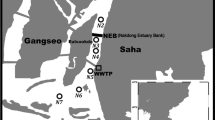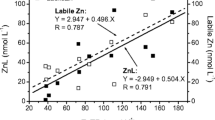Abstract
[Cu2+] and Cu complexation parameters in some selected freshwater systems in Switzerland were determined by the technique of ligand-exchange and DPCSV. Results from the water columns of some eutrophic and oligotrophic lakes are presented and compared to small acid lakes. Cu is strongly complexed by organic ligands which with very high stability constants at low concentrations are probably biologically produced, as indicated by the seasonal variations in the eutrophic lakes and by the relationship between Cu complexation and algal activity in the eutrophic (pCu=15−16), oligotrophic (pCu=13−14) and acidic (pCu=9−10) lakes. The extent of Cu complexation in river waters was generally lower than in the eutrophic lakes, at similar DOC levels. No obvious correlation between Cu complexation and DOC was observed, indicating that Cu complexing ligands are specific organic compounds.
Similar content being viewed by others
References
Ambühl, H., 1987. Seenrestaurierung in Theorie und Praxis: Eine Aufgabe des modernen Gewässerschutzes. Gas Wasser Abwasser 67:433–438.
Bloesch, J. and U. Uehlinger, 1990. Epilimnetic carbon flux and turnover of different particle size classes in oligo-mesotrophic lake Lucerne, Switzerland. Arch. Hydrobiol. 118:403–419.
Balistrieri, L. S., J. W. Murray and B. Paul, 1992. The biogeochemical cycling of trace metals in the water column of Lake Sammamish, Washington: response to seasonally anoxic conditions. Limnol. Oceanogr. 37:529–548.
Balistrieri, L. S., J. W. Murray and B. Paul, 1994. The geochemical cycling of trace elements in a biogenic meromictic lake. Geochim. cosmochim. Acta 58:3993–4008.
Brand, L. E., W. G. Sunda and R. R. L. Guillard, 1986. Reduction of marine phytoplankton reproduction rates by copper and cadmium. J. Exp. Mar. Biol. Ecol. 96:225–250.
Bruland, K. W., J. R. Donat and D. A. Hutchins, 1991. Interactive influences of bioactive trace metal on biological production in oceanic water. Limnol. Oceanogr. 36:1555–1577.
Calderoni, A., R. Mosello and D. Ruggiu, 1992. Sixty years of limnology on lago d'Orta: a case history of recovery from heavy pollution. Mem. Ist. ital. Idrobiol. 50:201–223.
Campos, M. L. A. M. and C. M. G. van den Berg, 1994. Determination of copper complexation in sea water by cathodic stripping voltammetry and ligand competition with salicylaldoxime. Anal. Chim. Acta 284:481–496.
Camusso, M., G. Tatari and A. Zirino, 1991. Measurement and prediction of copper ion activity in Lake Orta, Italy. Environ. Sci. Technol. 25:678–683.
Coale, K. H. and K. W. Bruland, 1988. Copper complexation in the Northeast Pacific. Linmnol. Oceanogr. 33:1084–1101.
Coale, K. H. and K. W. Bruland, 1990. Spatial and temporal variability in copper complexation in the North Pacific. Deep-Sea Res. 37:317–336.
Donat, J. R., K. A. Lao and K. W. Bruland, 1994. Speciation of dissolved copper and nickel in south San Francisco bay: a multi-method approach. Anal. Chim. Acta 284:547–571.
Donat, J. R. and C. M. G. Van den Berg, 1992. A new cathodic stripping voltammetric method for determining organic copper complexation in seawater. Mar. Chem. 38:69–90.
Gächter, R. and J. S. Meyer, 1990. Mechanisms controlling fluxes of nutrients across the sediment/water interface in a eutrophic lake. In: R. Baudo, J. Giesy nd H. Muntau (eds.), Sediments: Chemistry and Toxicity of In-Place Pollutions. Lewis Publishers, pp. 131–162.
Hirose, K., Y. Dokiya and Y. Sugimura, 1982. Determination of conditional stability constants of organic copper and zinc complexes dissolved in seawater using ligand exchange method with EDTA. Mar. Chem. 11:343–354.
Jakob, A., J. Zobrist, J. S. Davis, P. Liechti and L. Sigg, 1994. NADUF-Langzeitbeobachtung des chemisch-physikalischen Gewässerzustandes. Gas, Wasser, Abwasser 171–186.
Kari, F. G., 1994. Umweltverhalten von Ethylendiamintetraacetat (EDTA) unter spezieller Berücksichtigung des photochemischen Abbaus. Ph.D. Thesis No. 10698, Swiss Federal Institute of Technology, ETH Zürich.
Knauer, K., R. Behra and L. Sigg, 1995. Interactions of copper and zinc with freshwater algae. Submitted.
Martell, A. E. and R. M. Smith, 1974–1989. Critical stability constants. V. 1–6. Plenum.
Meyns, S., R. Illi and B. Ribi, 1994. Comparison of chlorophyll a analysis by HPLC and spectrophotometry: where do the differences come from? Arch. Hydrobiol. 132:129–139.
Miller, L. A. and K. W. Bruland, 1994. Determination of copper speciation in marine waters by competive ligand equilibration/liquid-liquid extraction: an evaluation of the technique. Anal. Chim. Acta 284:573–586.
Moffett, J. W., R. G. Zika and L. E. Brand, 1990. Distribution and potential sources and sinks of copper chelators in the Sargasso sea. Deep-Sea Res. 37:27–36.
Mosello, R., A. Calderoni and R. de Bernardi, 1991. Mass budget as a tool predicting the response to liming of the acidified, ammonium polluted Lake Orta. Verh. Internat. Verein. Limnol. 24:1044–1048.
Scarano, G., E. Bramanti and A. Zirino, 1992. Determination of copper complexation in sea water by a ligand competition technique with voltammetric measurement of the labile metal fraction. Anal. chim. Acta 264:153–162.
Sigg, L. and H. B. Xue, 1994. Metal speciation: concepts, analysis and effects. In: G. Bidoglio and W. Stumm (Eds.), Chemistry of aquatic systems: local and global perspectives, Kluwer, pp. 153–181.
Stadelmann, P., 1988. Zustand des Sempachersees vor und nach Inbetriebnahme der seeinternen Massnahmen: Künstlicher Sauerstoffeintrag und Zwangszirkulation 1980–1987. Wasser, Energie, Luft 80:81–96.
Sunda, W. G., 1988/89. Trace metal interactions with marine phytoplankton. Biological Oceanogr. 6:411–442.
Sunda, W. G. and R. R. L. Guillard, 1976. The relationship between cupric ion activity and the toxicity of copper to phytoplankton. J. Mar. Res. 34:511–529.
Sunda, W. G. and P.J. Hanson, 1979. Chemical speciation of copper in river water. In: E. A. Jenne (ed.), Chemical modeling in aqueous systems. American Chemical Society, Washington pp. 147–180
Sunda, W. G. and A. K. Hanson, 1987. Measurement of free cupric ion concentration in seawater by a ligand competition technique involving copper sorption onto C18 SEP-PAK cartridges. Limnol. Oceanogr. 32:537–551.
Sunda, W. G. and S. A. Huntsman, 1991. The use of chemiluminescence and ligand competition with EDTA to measure copper concentration and speciation in seawater. Mar. Chem. 36: 137–163.
Tipping, E. and M. A. Hurley, 1992. A unifying model of cation binding by humic substances. Geochim. Cosmochim. Acta 56:3627–3641.
Van den Berg, C. M. G., 1984. Determination of the complexing capacity and conditional stability constants of complexes of copper (II) with natural organic ligands in seawater by cathodic stripping voltammetry of copper-catechol complex ions. Mar. Chem. 15:1–18.
Van den Berg, C. M. G., A. G. A. Merks and E. K. Dursma, 1987. Organic complexation and its control of the dissolved concentration of copper and zinc in the Scheldt estuary. Estuarine Coastal Shelf Sci. 24:785–797.
Van den Berg, C. M. G., M. Nimmo, P. Daly and D. R. Turner, 1990. Effects of the detection window on the determination of organic copper speciation in estuarine waters. Anal. Chim. Acta 232:149–159.
Westall, J. C., 1982. FITEQL. A program for the determination of chemical equilibrium constants from experimental data. Oregon State Univ., Corvallis.
Whitfield, M. and D. R. Turner, 1987. The role of particles in regulating the composition of seawater. In: W. Stumm (ed.), Aquatic surface chemistry. Wiley-Interscience.
Xue, H. B. and L. Sigg, 1993. Free cupric ion concentration and Cu (II) speciation in a eutrophic lake. Limnol. Oceanogr. 38:1200–1213.
Xue, H. B., F. G. Kari and L. Sigg, 1995. Speciation of EDTA in natural waters: Exchange kinetics of Fe-EDTA in river water. Environ. Sci. Technol. 29:59–68.
Xue, H. B., D. Kistler and L. Sigg, 1995. Competition of copper and zinc for strong ligands in a eutrophic lake. Limnol. Oceanogr. 40:1142–1152.
Author information
Authors and Affiliations
Rights and permissions
About this article
Cite this article
Xue, H., Oestreich, A., Kistler, D. et al. Free cupric ion concentrations and Cu complexation in selected Swiss lakes and rivers. Aquatic Science 58, 69–87 (1996). https://doi.org/10.1007/BF00877641
Received:
Accepted:
Issue Date:
DOI: https://doi.org/10.1007/BF00877641




